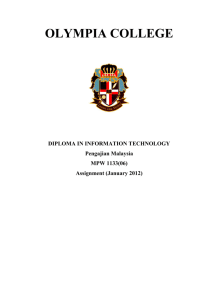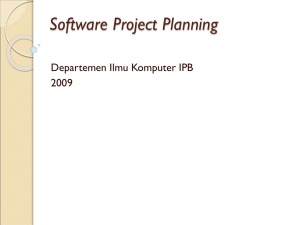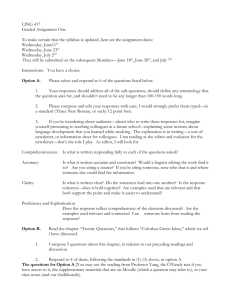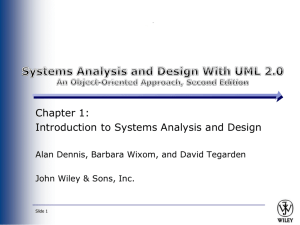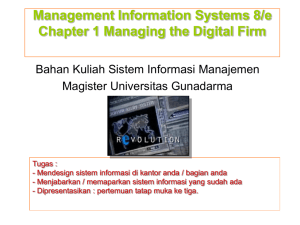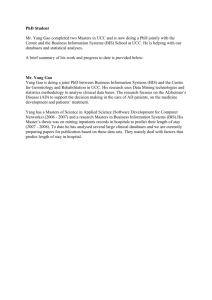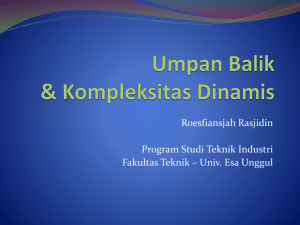proses penyediaan belanjawan
advertisement
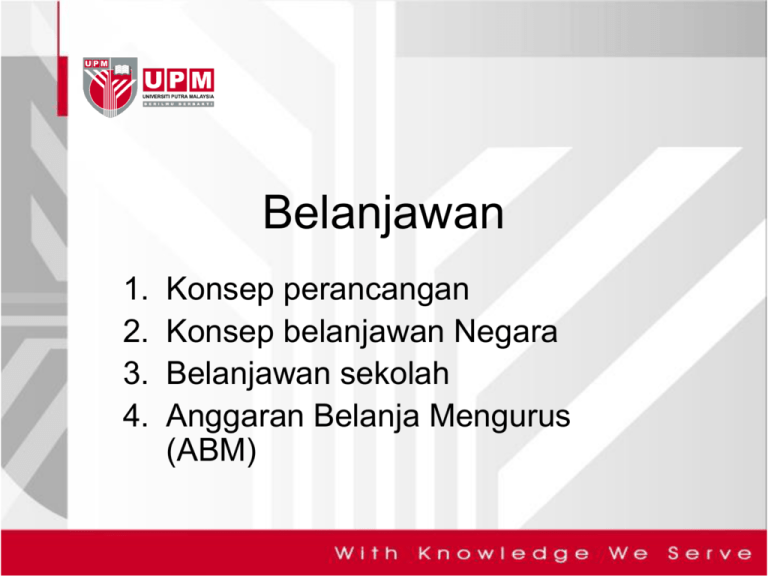
Belanjawan 1. 2. 3. 4. Konsep perancangan Konsep belanjawan Negara Belanjawan sekolah Anggaran Belanja Mengurus (ABM) KONSEP PERANCANGAN Plans and priorities • To manage school finance effectively, a manager needs a clear longer-term plans and priorities. • Financial management without plans and priorities is just like a house without foundations. • Plans need long-term objectives. • Need a thorough analysis of the school’s current performance and situation. • A SWOT analysis will produce a useful starting point. SWOT ANALYSIS • Strengths – what are these, currently? • Weaknesses – what are these? • Opportunities – what opportunities are likely to arise in the future? • Threats – what threats are likely to arise? • Need to consider the school’s environment, internal resources, organizational culture, school’s performance, and outcomes. PLANNING MODELS • • • • RATIONAL PRAGMATIC ENTREPRENEURIAL LATERAL MODEL ‘A’ The rational approach • Analysis of school ’s current performance and situation. • Produce long term mission, goals or vision of the school. • Objectives - what is to be achieved, when, what criteria? • Plans - what to be done to achieve objectives? MODEL ‘A’ The rational approach C (not visible from B) Goal B A The rational approach MODEL ‘A’ The rational approach • Resources - human, financial and physical resources required. • Implementation - how, when and by whom? • Monitoring and evaluation - how is it going, criteria for evaluation, and have the objectives been achieved? Weaknesses • Schools are not necessarily rational organisations. Garbage can model. • Rational plan needs predictable and stable environment. • Can only plan for what you can see. MODEL ‘B’ The pragmatic approach • Planning must be a learning and responsive process, learning to understand our changing environment and respond to it (Knight, 1993). • Flexible and builds on existing strengths. MODEL ‘B’ The pragmatic approach Goals A Set backs of MODEL ‘B’ • Lack clarity of objectives. • Short-term. • Responds inadequately to sudden change. MODEL ‘C’ Entrepreneurial approach • Exploiter of opportunity. • Positive search for opportunities. • Example: school offering relevant programmes to another organisation. • Changes in school uniform. • Community education. MODEL ‘C’ Entrepreneurial approach Philosophy and values C B A MODEL ‘D’ The lateral approach • Visionary statement of future goals and identification of possible routes. • Indepth analysis, brain-storming and divergent thinking are required. MODEL ‘D’ The lateral approach Vision or goal D z B y A KONSEP BELANJAWAN NEGARA Konsep Belanjawan • Belanjawan merupakan suatu penyataan Hasil dan Perbelanjaan bagi suatu masa hadapan yang digunakan sebagai alat perancangan sumber ekonomi negara untuk memenuhi keperluan negara dan rakyat; • Ianya memainkan peranan penting dalam menentukan arah tuju dan kedudukan ekonomi negara. OBJEKTIF: • Untuk menentukan agensi Kerajaan diberikan peruntukan yang sewajarnya bagi digunakan dengan cekap dan berkesan untuk setiap program dan aktiviti selaras dengan Dasar Belanjawan Negara JENIS BELANJAWAN Anggaran belanjawan yang disediakan 1. Anggaran Belanjawan Mengurus (operasi) 2. Anggaran Belanjawan Pembangunan 3. Anggaran Belanjawan Kumpulan Wang Amanah dan Akaun Amanah • Jangka pendek – 2 tahun (belanja mengurus, perbelanjaan pembangunan) • Jangka panjang – 5 tahun SISTEM BELANJAWAN YANG DIGUNA Sebelum 1968 – Sistem Belanjawan Tradisional • Line Item Budgeting • Bottom-up • Zero Based Budgeting 1968 – 1990: Sistem Belanjawan Program & Prestasi (SBPP) – PP 5/68 • Program / Aktiviti • Prestasi Perbelanjaan 1990 hingga kini Sistem Belanjawan Diubahsuai MBS • Menitikberatkan hubungan Input-Output-Impak BELANJAWAN – ALAT MENGURUS SUMBER KEWANGAN Proses belanjawan yang rapi mengandungi 1. Objektif 2. Program 3. Aktiviti 4. Projek yang dipilih 5. Spesifikasi output 6. Impak 7. Penilaian program Alat Pengukuran Prestasi 1. Samada perbelanjaan dibelanjakan mengikut perancangan 2. Melihat objektif tercapai atau tidak SISTEM BELANJAWAN UBAH SUAI- CIRI-CIRI 1. Batas Perbelanjaan (Expenditure Target – E.T) 2. Perjanjian Program dan Laporan Penilaian (Program Agreements and Exceptions Reports) 3. Satu pusingan penilaian program (Cycle of Program Evaluations) 4. Satu kawalan menyeluruh terhadap kawalan peruntukan. (A More Generalized Approach to Expenditure Control) CIRI PERBELANJAAN UBAH SUAI – ISTILAH • Dasar sedia ada vs Dasar baru • Peruntukan one-off vs Perbelanjaan berulang • Nilai Threshold SISTEM BELANJAWAN UBAH SUAI Batas Perbelanjaan • Satu jumlah peruntukan yang telah ditetapkan di peringkat permulaan proses belanjawan tahunan bagi sesuatu agensi untuk membiayai dasar sedia ada bagi tahun berkenaan. Dasar Sedia Ada • Program-program yang telah diluluskan dalam bentuk perundangan, kelulusan kabinet, Menteri atau Perbendaharaan atau lain-lain Pihak Berkuasa yang setaraf. SISTEM BELANJAWAN UBAH SUAI Peruntukan Dasar Baru • Perbelanjaan untuk aktiviti baru termasuk tambahan, sambungan atau perluasan kepada dasar sedia ada seperti (dalam universiti – penawaran program baru dan penubuhan PTJ baru). • Program/aktiviti baru yang memerlukan perbelanjaan berulang. SISTEM BELANJAWAN UBAH SUAI Peruntukan One-Off • Suatu perbelanjaan yang tidak berulang seperti mengecat bangunan, kerja-kerja menaiktaraf dan penyelenggaraan, penggantian aset usang dan pembelian aset baru bagi program dan aktiviti sedia ada. • Tiada kesinambungan peruntukan dari tahun pertama ke tahun berikutnya. • Hendaklah dipastikan peruntukan one-off yang telah diluluskan bagi tahun-tahun lepas tidak diulang dalam tahun belanjawan semasa. SISTEM BELANJAWAN UBAH SUAI Threshold • Satu nilai yang ditetapkan oleh Perbendaharaan bagi sesuatu agensi yang mana nilai ini digunakan sebagai ukuran untuk menentukan jumlah peruntukan tambahan yang wajar dilakukan oleh Perbendaharaan di dalam menimbangkan sesuatu cadangan Dasar Baru / One-Off. SISTEM BELANJAWAN UBAH SUAI Perjanjian Program • Satu persetujuan antara agensi dengan Perbendaharaan mengenai input yang akan digunakan, output yang akan dihasilkan dan impak yang akan dicapai untuk setiap aktiviti yang dirancang. SISTEM BELANJAWAN UBAH SUAI – elemen utama 1. The MBS is a system of management designed to establish logical linkages on the relationship between inputs, outputs and impacts. 2. The MBS is based on fundamental management principles of Letting managers manage 3. trying to improve resources allocation by bringing about more efficient management of government programs by way of improved accountability. A SHORT INTRODUCTION TO THE MALAYSIAN BUDGETING SYSTEM Koshy Thomas Deputy Undersecretary Ministry of Finance, Malaysia PROSES BELANJAWAN MBS RESULT-BASED BUDGETING UNDER MBS BELANJAWAN SEKOLAH DEFINITION FOR SCHOOL BUDGETING • A plan for the allocation and expenditure of resources to achieve the objectives of the school (Knight, 1993, p.128) • The focus is on planning and the need to relate expenditure to the achievement of objectives. FUNCTIONS OF SCHOOL BUDGETING Planning Forecasting Matching income and expenditure Establishing priorities Comparing activities through financial denominators Implementing plans Coordinating activities of the school Allocating resources Authorizing expenditure and actvities FUNCTIONS OF SCHOOL BUDGETING Communicating objectives and priorities to personnel Motivating personnel by delegating responsibilities Controlling and monitoring expenditure Strengthening accountability Obtaining value for money, economy Matching outcomes against inputs Assessing cost effectiveness FOUR PHASES IN BUDGET PROCESS - KNIGHT No Phase . 1 Preliminary analysis Type Year Strategic 2 Budget construction Operational 3 Control and monitoring of expenditure Evaluation Operational Before financial year Before financial year During financial year After financial year 4 Strategic PROSES PENYEDIAAN BELANJAWAN SEKOLAH 4 fasa (Brian Knight, 1993) 1. Preliminary analysis (strategic, before financial year. Purpose, strategies) 2. Budget construction (operational, before financial year. Format, construction of draft budget, approval of final budget) 3. Control and monitoring of expenditure (operational, during financial year) 4. Evaluation (strategic, after financial year) PROSES PENYEDIAAN BELANJAWAN BUDGET STRATEGIES (Knight, 1993) 1. Incremental – adjusting the previous year’s budget with increments for any changes in volume. It is difficult to justify. 2. Pragmatic approach – base the new budget upon the old one and make improvement to the previous budget. 3. Base budget – use the school plan as the starting point (UK experience). PROSES PENYEDIAAN BELANJAWAN BUDGET STRATEGIES (Knight, 1993) 5. Zero budgeting – requires each activity to justify its claims for funds. Useful for questioning the status quo, reducing expenditures for which priorities have fallen and making space for new needs. 6. Planning Programming Budgeting System – relate budget to measurement of achievement. THE BEST STRATEGY? Needs to adopt a system that fits own needs and meets criteria – Respond to needs of different subject areas Take account of priorities Promote achievement of the school’s objectives Encourage innovation Facilitate long-term planning React rapidly to environmental change Facilitate evaluation of sub-units Take account of patterns of power and influence Ability to spend wisely Avoid incurring substantial time or other costs Be easily understood and widely accepted BUDGETARY MONITORING AND EVALUATION Monitoring compares the actual expenditure against estimated. Control safeguards funds and ensures money are spent as authorized. Normally variances occur – three stages of variances: 1. verification – are the figures correct? 2. interpretation – what does the variance mean? 3. corrective action – adjustments needed BUDGETARY MONITORING AND EVALUATION Evaluation of the budget – 3 aspects: 1. financial efficiency – compare the out-turn budget with the start-of-year budget. 2. resource efficiency – looking at what the money was spent on. 3. effectiveness – assessing whether the expenditure has achieved the outcomes hoped for. ANGGARAN BELANJA MENGURUS- SEKOLAH PTJ
